|
Morocco:
West Atlas Bicycle Africa / Ibike Tours |
|||
 |
Western Atlas: Meknes | ||
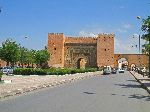 |
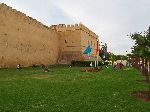 Meknes
is the most laidback of the former Imperial Capitals. The
districts of Meknes mirror its history. The oldest section is the walled medina
filled with townhouses and souks (markets). Its basic footprint today dates back to about the 10th century when the town
developed to service
the broad surrounding agricultural community. The 'Imperial City', grand
gates and protective wall are the product of Moulay Ismail, the second emperor of
the Alaouite Dynasty, and one of Morocco greatest and most despotic leaders. He made Meknes
the capital when he came to power in 1672, and reigned for 55 years (until
1727). Construction of the royal complex, as envisioned, still wasn't completed
at the time of his death. The town returned to its agrarian roots when the
capital was moved to Marrakech in 1755. Meknes
is the most laidback of the former Imperial Capitals. The
districts of Meknes mirror its history. The oldest section is the walled medina
filled with townhouses and souks (markets). Its basic footprint today dates back to about the 10th century when the town
developed to service
the broad surrounding agricultural community. The 'Imperial City', grand
gates and protective wall are the product of Moulay Ismail, the second emperor of
the Alaouite Dynasty, and one of Morocco greatest and most despotic leaders. He made Meknes
the capital when he came to power in 1672, and reigned for 55 years (until
1727). Construction of the royal complex, as envisioned, still wasn't completed
at the time of his death. The town returned to its agrarian roots when the
capital was moved to Marrakech in 1755. |
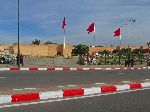
|
|
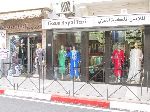 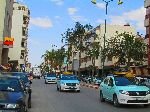 The
next big change to Meknes didn't come for over 150 years, when in 1912, the French
Protectorate made Meknes its military headquarters and developed modern Meknes Nouvelle
across the river from the medina and Imperial City. The
next big change to Meknes didn't come for over 150 years, when in 1912, the French
Protectorate made Meknes its military headquarters and developed modern Meknes Nouvelle
across the river from the medina and Imperial City. |
|||
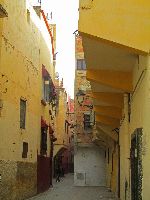 |
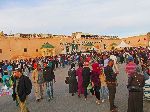 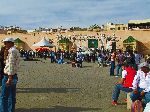 Centrally
located,
between the medina, the Mellah (old Jewish quarter) and the Imperial City, is Place el-Hedim. In many ways, it
is a miniature of the huge square, Djemaa El-Fna, of Marrakech: It is lined with cafés,
restaurants as shops, and in the plaza there are assorted vendors, families
and groups of young people. Centrally
located,
between the medina, the Mellah (old Jewish quarter) and the Imperial City, is Place el-Hedim. In many ways, it
is a miniature of the huge square, Djemaa El-Fna, of Marrakech: It is lined with cafés,
restaurants as shops, and in the plaza there are assorted vendors, families
and groups of young people.Also similar to Marrakech, there are horse-drawn carriages for hire. |
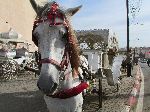 |
|
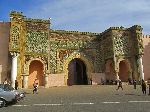 |
Facing Place el Hedim and protecting the Imperial City, is the most impressive of the gate in Meknes' Imperial City, Bab Mansour. It was not finished until 1732, five years after Moulay Ismail's death. It is named after the architect who designed it. Like is so frequently the case in Morocco, the marble columns were taken from another location, in this case from the nearby Roman ruins of Volubilis. It is an early example of recycling and repurposing. It might have been economical and expedient for Meknes, but it reeked havoc on the integrity and heritage of Volubilis. |
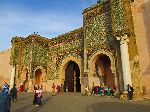 |
|
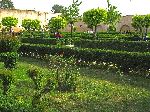 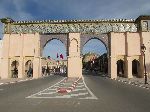 Through
the gates and inside the royal enclosure the grounds are very spacious. There
are large gardens -- and even larger parking lots that probably did exist in the
18th century. Through
the gates and inside the royal enclosure the grounds are very spacious. There
are large gardens -- and even larger parking lots that probably did exist in the
18th century.The enclosure is also divided into sections by additional interior walls and gates. |
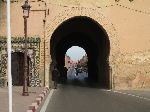 |
||
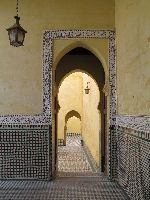 |
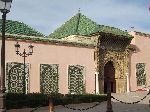
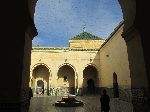
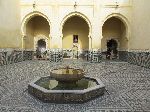
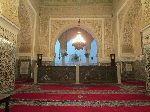 The finest building, that the public has access to in the royal complex in Meknes, is the Mausoleum of Moulay Ismail. After you enter, it is a long walk through several somber, aesthetically pleasing, relatively austere halls, and courtyards, past fountains and side rooms, designed to calm you, and let you transition before you reach the lavish, formal, ornately finished burial room fit for a king. The total coverage, floor to ceiling craftsmanship, includes the best of Moroccan carpet weaving, tile work, and plaster carving. |
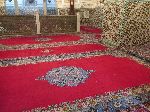 |
|
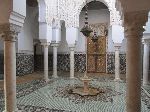 |
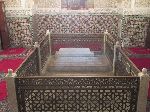
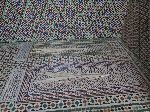
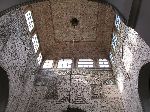
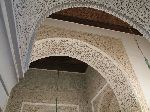 |
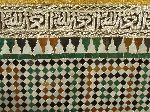 |
|
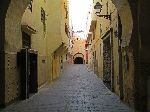
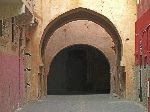
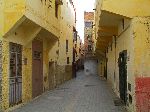 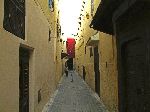 |
|||
|
Typical of the older, urban, residential areas in other Moroccan cities, the
streets in the older residential districts of Meknes are narrow and intimate. On the outskirts of Meknes, the traffic circles are ringed with flags, often Moroccan flags, but this one (right) is festooned with flags of nations of the world. |
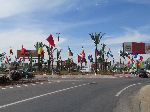 |
||
|
|
|||
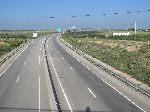 |
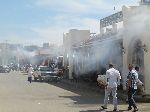 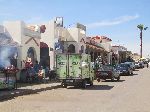 Heading
south across the plains from Meknes, after passing the expressway, is Boufekrane.
There may be more to it than meets the eye, but what meets the eye is a long
strip of restaurants far in excess of what would seem to be local demand. The
restaurant primarily serving roasted meat and tajine. This must be the magic
hunger zone for those traveling from the coast to Ifrane or across the Atlas. Heading
south across the plains from Meknes, after passing the expressway, is Boufekrane.
There may be more to it than meets the eye, but what meets the eye is a long
strip of restaurants far in excess of what would seem to be local demand. The
restaurant primarily serving roasted meat and tajine. This must be the magic
hunger zone for those traveling from the coast to Ifrane or across the Atlas. |
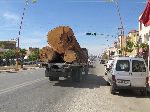 |
|
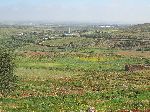 |
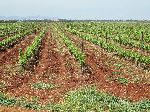 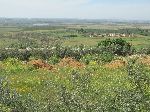 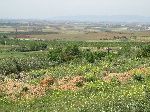 Beyond
the city and towns, the countryside is a patchwork of cultivated fields, with the
occasional small village. The crops include grapes, wheat, corn, beans, fruit
orchards and
assorted other grains and vegetable. Beyond
the city and towns, the countryside is a patchwork of cultivated fields, with the
occasional small village. The crops include grapes, wheat, corn, beans, fruit
orchards and
assorted other grains and vegetable. |
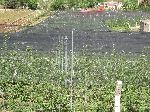 |
|
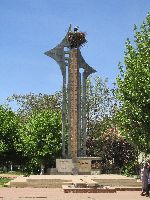 At
the edge of the fertile plains is the small town of El Hajeb. El Hajeb is built
on ledges at the foot of the hills and split into a couple sections on different
levels. The most notable feature of El Hajeb is a monument. The most notable
features of the monument are the storks living on top and the dominate script on
the column is Berber. The narrative description on the stones at the base of the
monument are in
Arabic and has dates of 1793, 1973 and 2005. At
the edge of the fertile plains is the small town of El Hajeb. El Hajeb is built
on ledges at the foot of the hills and split into a couple sections on different
levels. The most notable feature of El Hajeb is a monument. The most notable
features of the monument are the storks living on top and the dominate script on
the column is Berber. The narrative description on the stones at the base of the
monument are in
Arabic and has dates of 1793, 1973 and 2005. |
|||
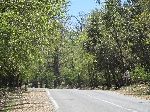 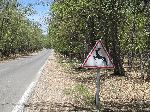 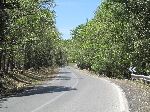 East of the plains is the Moyen (Middle) Atlas. On a long section of the 30-kilometer slopes, on the mountains, between el Hajeb and Ifrane, is the Parc National d'Ifrane. If you are heading the right direction (west) it is a very pleasant bike ride -- in the opposite direction, not so much so. |
|||
|
|
|||
|
|
Unique Programs To Special Places For Memories Of A Lifetime!
"Hosted by
DreamHost - earth friendly web hosting"
|
|